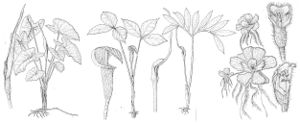Arisaema
Flora 14: 459. 1831.
| Taxon | Illustrator ⠉ | |
|---|---|---|
 | Pistia stratiotes Colocasia esculenta Arisaema triphyllum Arisaema dracontium | John Myers John Myers John Myers John Myers |
Herbs, terrestrial or wetland. Corms [rhizomes] nearly globose. Leaves usually appearing with flowers, 1–2 (–3), erect; petiole longer than blade; blade medium to dark green, sometimes glaucous adaxially, palmately or pedately [radiately] divided, not peltate, leaflet elliptic to broadly ovate or oblanceolate, base rounded to obtuse or attenuate, apex obtuse or acute to acuminate; primary lateral-veins of each leaflet pinnate. Inflorescences: peduncle erect, nearly equal to leaves [to very short], apex not swollen; spathe variously colored or striped, distal part open at maturity, exposing tip to 1/2 or more of spadix appendage; spadix ± cylindric, surmounted by sterile appendage of variable shape. Flowers unisexual, staminate and pistillate on same or different spadix; pistillate flowers congested; staminate flowers usually scattered, distal to pistillate flowers when both present; perianth absent. Fruits not embedded in spadix, glossy orange to bright red. Seeds 1–6, mucilage sometimes present (not present in Arisaema triphyllum). x = 13, 14.
Distribution
Mostly temperate Asia, also North America, Mexico, and Africa
Discussion
The phenomenon of sex changing in Arisaema has been investigated by many authors (e.g., P. Bierzychudek 1982; K. Clay 1993; E. Kinoshita 1986). Smaller plants produce only staminate flowers, and larger plants produce either staminate and pistillate flowers simultaneously or pistillate flowers only. Changes in gender expression are directly correlated with size and are also influenced by the environment in which the plants are growing. Reversions in phenotypic gender have been experimentally induced by such factors as removing leaf area or changing soil nutrient levels.
Although some species are cultivated as ornamentals, the genus is not of great economic importance.
Species ca. 170 (2 in the flora).
Selected References
Lower Taxa
Key
| 1 | Leaflets 3(–5); spadix blunt apically, shorter than spathe. | Arisaema triphyllum |
| 1 | Leaflets (5–)7–13(–21); spadix tapering apically, longer than spathe. | Arisaema dracontium |